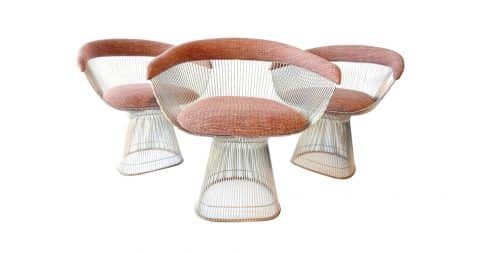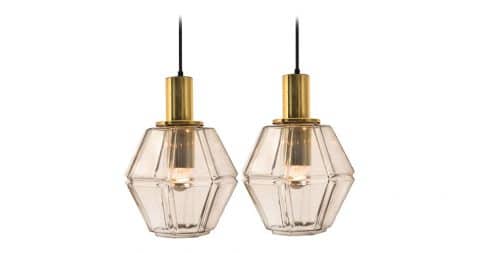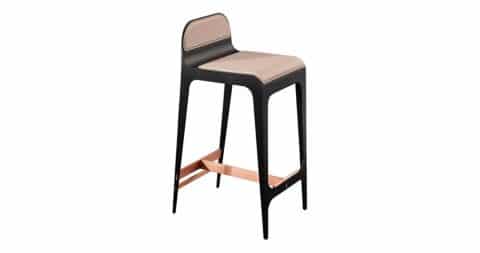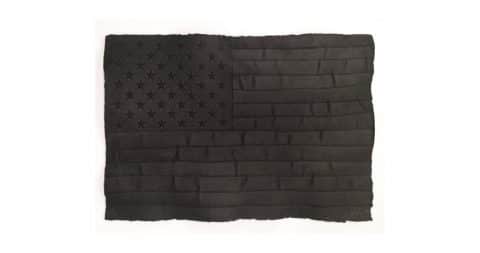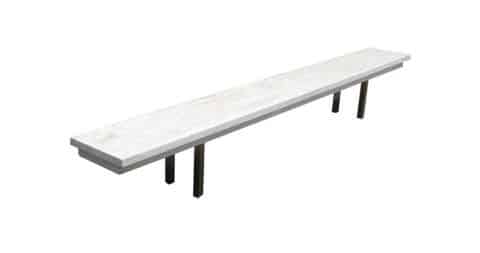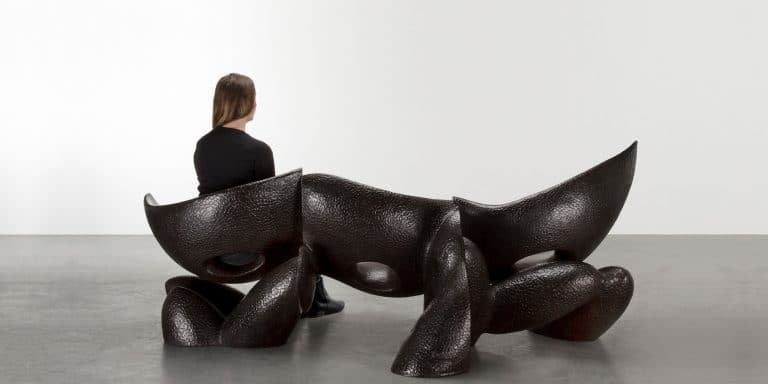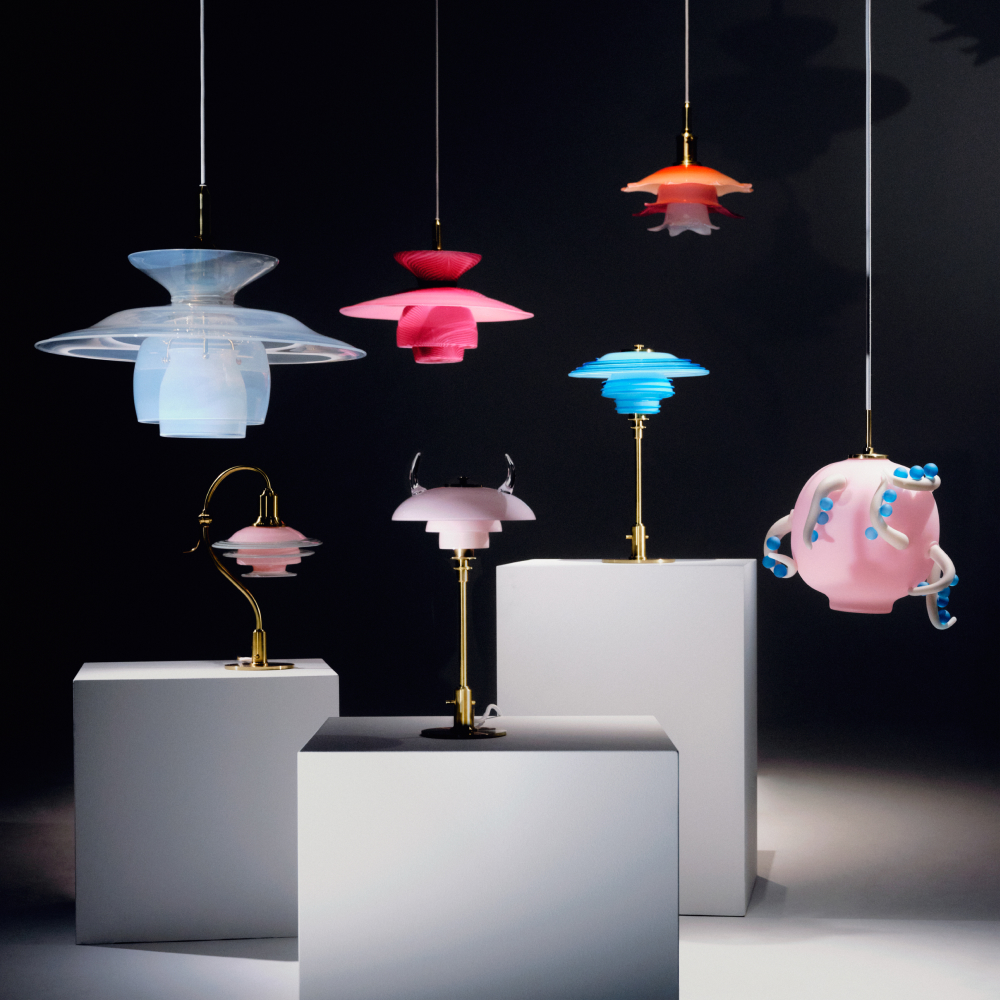
March 19, 2018Gabriel Kakon (left) and Scott Richler, who launched Gabriel Scott in 2012, are preparing to introduce their first seating collection (portrait by James Andrew Rosen). Top: A Welles glass chandelier hangs in Gabriel Scott’s Manhattan showroom (photo by Chris Mottalini).
Gabriel Kakon arrives at his New York showroom to meet a reporter after what he calls a “forty-five-minute flight from Montreal,” which is his home and also the base of operations for Gabriel Scott, the furniture and lighting company he cofounded in 2012 with his business partner, Scott Richler.
Kakon is slightly understating the travel time, but it’s still a relatively short trip from Montreal, so the pair can easily come down for just a day to their chic Nolita showroom, located in a former carriage factory where exposed-brick walls and salvaged-wood floors are juxtaposed with Gabriel Scott’s gleaming marble tables and gem-like lighting.
Given the furniture’s bold silhouettes, ergonomic design and handmade construction, it’s no wonder that Kakon and Richler have backgrounds in architecture, or that their young business is thriving. But although their professional partnership is relatively new, their relationship is not. In fact, they’re brothers-in-law of long standing.
“He’s been part of our family since I was about ten years old,” Kakon says of Richler, who is married to Kakon’s older sister, Jennifer. “They were basically high-school sweethearts.” Richler and Jennifer were also business partners, launching Jennifer Scott, a line of handbags and accessories, in 1999 after Richler finished architecture school at McGill University.

A pair of Welles glass chandeliers hang over a marble-topped Dean dining table and Bardot chairs in the Gabriel Scott showroom. Lighting pieces displayed in the background include Harlow pendants and a Harlow Dried Flowers chandelier.

A Prong mirror leans against a showroom wall, flanked by a pair of Welles glass double wall sconces. Photo by Chris Mottalini
“We were doing things that were well received,” Richler says of the line, which was carried in stores like Bergdorf Goodman, Harrod’s and Saks Fifth Avenue and whose Bond Bag was called “the must-have purse of 2003” by the Globe and Mail. But following a series of events that Richler calls a “comedy of errors” — including a shift in the global economy, a spike in prices by high-end brands and an industry-wide move to manufacturing in China — they no longer felt that they could compete in such a turbulent market. At the same time, Richler was developing an interest in making furniture, even opening a custom boutique, Jennifer Scott Décor, next to their flagship store in Old Montreal. He found his new industry a better fit. “The pace of furniture and lighting is much more humane” than that of fashion, Richler says, “and the products are much less disposable.”
In the years that followed, Richler began collaborating with Kakon, who had also pursued a career in architecture and design, on custom furniture for their own projects and those of other designers. “We’re complementary in terms of what we bring to the table,” Kakon explains. “We were influenced by a lot of the same things growing up, but because he’s older I’ve learned a lot from him.”
Eventually, they saw the potential in offering their work to an audience outside their Montreal network. “To do that,” Kakon says, “we really needed to put together a collection of furniture and lighting pieces that was exportable, that was engineered to be smart, cost-efficient and shippable.”
The pair debuted their initial Gabriel Scott collection at ICFF in 2013, showing their Dean series of glass-topped tables and their Kelly chandelier, composed of brass or steel blades strung with rows of glittering, necklace-like chains. “Those were our first pieces,” Kakon says. “They reflected our vision then, and they’re still very much our vision.” That is to say, the distinct forms and jewelry references of that early series also define their subsequent pieces, such as the faceted Briolette pendants and the prong-like bases of the aptly named Prong tables.

At Gabriel Scott’s Montreal studio, an employee works with components of the firm’s Welles, Myriad and Briolette lighting pieces. Photo by James Andrew Rosen

A Welles chandelier hangs over a Prong dining table and Bardot chairs in the showroom. Photo by Chris Mottalini
The jewelry influence isn’t a coincidence, as Richler also has a background in jewelry design. “Lighting is consumed and treated very much like jewelry,” Kakon says. “It’s purchased maybe just a couple of times in your life, it’s a big commitment and investment, but it’s something you’ll have for years and years or give to your children.” So, Kakon says, the challenge is designing timeless pieces. “They have to be tasteful without being too much on-trend, which would make them cool now, but irrelevant in a couple of years.”
This focus on timelessness has helped Gabriel Scott build a roster of high-profile retail and hospitality clients, including Cartier, the Four Seasons and Saks Fifth Avenue. Their work is also featured in the house Martyn Lawrence Bullard designed for Kylie Jenner, and in Chrissy Teigen and John Legend’s Los Angeles home by Desiderata Design. The firm has a staff of about 25 working in its Montreal studio, which is located in the city’s old garment district. That is the base of operations for the sales, research and development and production teams, and the firm’s suppliers are all within a few miles. “No matter how big we grow,” Kakon says, “I think that’s something we’ll always stress: being able to produce locally.”
Currently, the partners are focused on finishing up a line of seating, their first major foray into the category following the launch of their Bardot chairs and bar stools in 2016. They plan to introduce a collection of about four or five seating pieces in May. “They’ll carry the same strong elegant lines and still be functional as a couch or daybed or chaise,” Kakon says. Adds Richler: “It’s an entirely new field of exploration, and it brings a whole other set of challenges about design, material selection, marketing and distribution. It’s almost like starting a new business.”
The continuing growth and evolution of their business have been particularly rewarding, Kakon says. “Constantly being exposed to opportunities from which you can pick and choose and compare and putting those things into action rather than just dreaming about them have really been exciting for us.”
Gabriel Scott’s Quick Picks on 1stdibs

